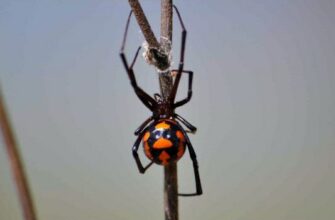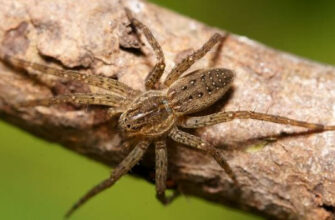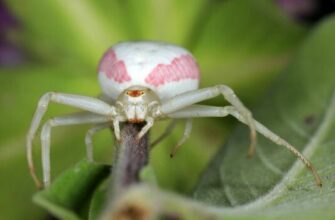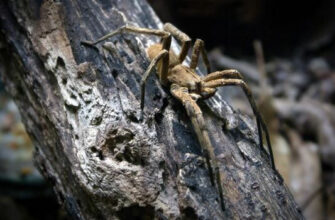Water spider – although quite small and harmless in appearance, but poisonous. It is notable for the fact that it lives under water, for which it builds a dome with air. Because of this, it got its second name, silverfish – small droplets of water on its hairs, refracting through the air of the dome, glisten in the sun and create a silvery glow.
Origin of the species and description
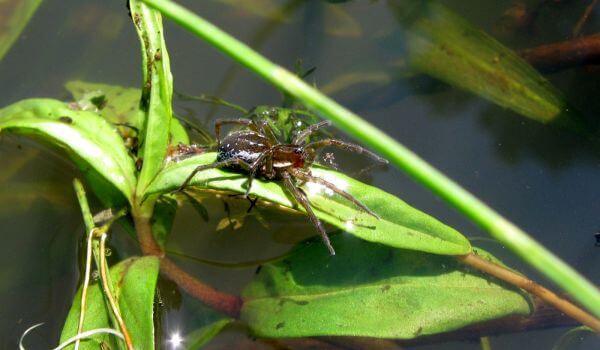
Photo: Water Spider
Arachnids arose a very long time ago – the oldest fossil species are known in the Devonian deposits, and this is 400 million years BC. It was they who came to land first, at the same time their main distinguishing feature took shape – the arachnoid apparatus, and according to the assumptions of some scientists, it could even have arisen even in the water.
The degree of development of the spider, its place on the evolutionary ladder is largely determined precisely by the use of the web – the most primitive species use it only for cocoons, just like their most distant ancestors did. As they developed, spiders learned to use the web in other ways: to build nests, networks, signal systems from it.
Video: Water Spider
According to paleoanthologists, it was the invention of the Jurassic spiders of the trapping web, along with the appearance of flowering plants, that caused insects to acquire wings and take to the air – they sought to escape from the abundance of webs arranged by spiders.
Spiders turned out to be very tenacious, and during all five great extinctions, when most of the species disappeared from the face of the Earth, they managed not only to survive, but also to change relatively little. However, modern species of spiders, including the silverfish, are relatively recent: most of them are from 5 to 35 million years old, some even less.
Gradually, the spiders developed, so their initially segmented organs eventually began to function as a single whole, the abdomen also ceased to be segmented, the coherence of movements and the speed of reactions increased. But the evolution of most of the genera and species of spiders has not yet been studied in detail, this process continues.
This also applies to the water spider – it is not yet known for certain when they originated, as well as from whom. It is almost certain that they became an example of the return of land arachnids to the sea. This species was described by Karl Alexander Clerk in 1757, received the name Argyroneta aquatica and turned out to be the only one in the genus.
An interesting fact: Spiders are incredibly tenacious creatures – for example, after the eruption of the Krakatoa volcano, when, as it seemed, lava destroyed all life, arriving on the island, people were the first to meet a spider that twisted a web right in the middle of a lifeless desert.
Appearance and Features
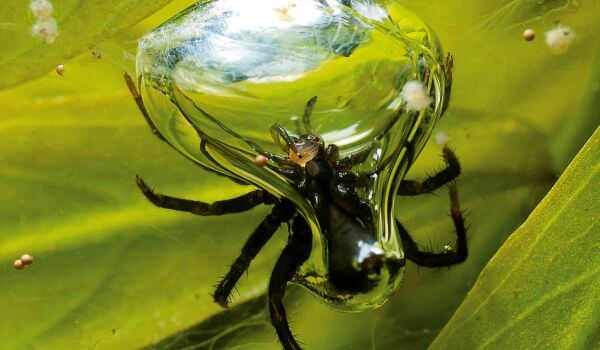
Photo: Water spider, aka silverfish
In terms of structure, it differs little from ordinary spiders living on land: it has four jaws, eight eyes and eight legs. The longest of the paws are located at the edges: the front ones are adapted for grabbing food, the back ones for swimming – and silverfish are good at doing this.
Only 12-16 mm in length, females are usually closer to the lower value of the range, and males to the upper. This is rare for spiders, usually they have larger females. As a result, silverfish females do not eat males, as in many other spider species. They also differ in the shape of the abdomen: the female has a rounded, and the male is much more elongated.
For breathing, it forms an air-filled bubble around itself. When the air comes to an end, pops up for a new one. In addition, in order to breathe, she has one more device – hairs on her abdomen smeared with a waterproof substance.
With their help, a lot of air is also retained, and when the spider emerges for a new bubble, at the same time it replenishes the supply of air retained by the hairs. Thanks to this, it feels great in the water, although it has to surface dozens of times a day.
The color of a water spider can be either yellow-gray or yellow-brown. In any case, a young spider has a light shade, and the older it gets, the darker it gets. At the end of life, it turns out to be almost completely black – so it is very easy to approximately estimate its age.
Where does the water spider live?
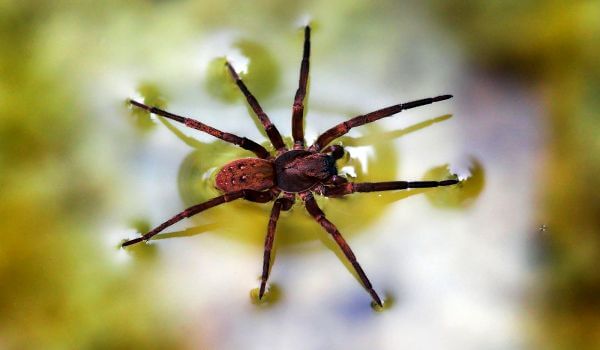
Photo: Water spider in Russia
Prefers a temperate climate, and lives in the territories of Europe and Asia located in it – from the Atlantic Ocean to the Pacific. It prefers to live in stagnant water, it is also permissible for it to flow, but slowly, which means that its main habitats are rivers, lakes and ponds. He especially loves abandoned, quiet places, preferably with clean water.
It is also desirable that the reservoir be abundantly overgrown with vegetation – the more it is, the higher the chance that silverfish live in it, and if they are, then most often there are a lot of them at once, although each arranges a separate nest for himself. Outwardly, the spider's home can either resemble a thimble or a small bell – it is woven from cobwebs and attached to the stones at the bottom.
It is very difficult to notice it, because it is almost transparent. In addition, it does not let air through. The spider spends most of its time in its underwater nest, especially for females – it is reliable and safe, because signal threads stretch in all directions from it, and if a living creature is nearby, the spider will immediately know about it.
Sometimes he builds several nests of different shapes. Silverworts can be kept as pets. This is quite rare, but it happens, because they can be interesting with their nests and silver glow. One spider can be kept in a small tank, and several need a full-fledged aquarium.
They do not conflict with each other, but if they are underfed, they can enter into a fight, after which the winner will eat the loser. They adapt well in captivity, but they need to arrange an environment of aquatic plants, and so that some of them show up on the surface (or throw branches) – this is necessary for the spiders to get out for air.
Although they are poisonous, but they are not inclined to attack people, this is only possible if the spider defends itself – such situations can occur when a silverfish is caught along with a fish, and she thinks that she was attacked. Usually it tries to escape from people, and the accustomed, captive spiders react calmly to their presence.
Now you know where the water spider lives. Let's see what he eats.
What does a water spider eat?
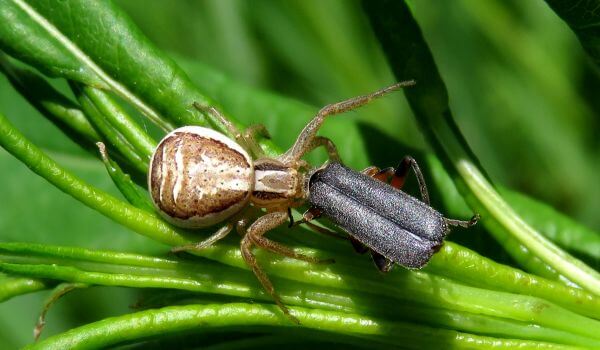
Photo: Water spider
The diet includes small animals that live in the water, these are:
- aquatic insects;
- larvae;
- water donkeys;
- flies;
- bloodworm;
- small crustaceans;
- fry of fish.
When attacking, she entangles the victim with cobwebs to constrain her movements, sticks chelicerae into her and injects poison. After the prey dies and ceases to resist, it injects a digestive secret – with its help, the tissues are liquefied, and it becomes easy for the silverfish to suck out all the nutrients from them.
In addition to hunting, they drag away and digest already dead insects floating on the surface of the reservoir – flies, mosquitoes, and so on. Most often, in captivity, a water spider is fed just by them, and it can also eat cockroaches. He drags prey with the help of a web into his dome and eats it already there.
To do this, he lies on his back and processes the food with a digestive enzyme, and when it softens enough, he sucks it into himself, then removes what turned out to be inedible from the nest – it is kept clean. Most of all, silverwomen like to eat water donkeys.
In the ecosystem, they are useful in that they destroy the larvae of many harmful insects, for example, mosquitoes, preventing them from breeding excessively. But they can also bring harm, because they hunt fish fry. However, the weakest fry become their prey, so they play the role of natural breeders, and do not do much harm to the fish population.
Interesting fact: Although the water spider has many eyes, but most of all, during the hunt, he does not rely on them, but on his web, with which he can feel every movement of the victim.
Character and lifestyle features
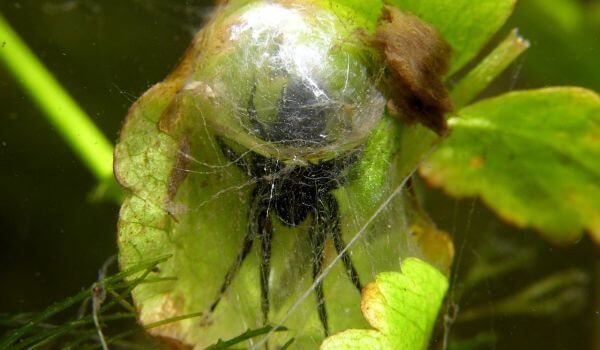
Photo: Funnel Water Spider
Silverfish go hunting at night, but rest most of the day. Females rarely leave the nest except to replenish their air supply – except perhaps for hunting. But even she is often led passively, barely leaning out of the nest, and waiting until some prey is nearby.
Males are much more active and can move away from the nest up to a dozen meters away in search of food. Although most often they also remain within a meter or two, under the protection of their networks, ready to respond to signals coming from them at any moment.
They can hibernate either in cocoons that they themselves weave, or in empty shells of mollusks. Their silverfish are very interestingly prepared for wintering: they drag air inside until they float up, then attach them to duckweed and crawl inside the shell.
When the shell is ready, you can fall into hibernation – inside it will be warm enough for the water spider to survive even in the most severe cold. Such floating shells can be seen in the autumn months – this is a sure sign that the silverfish lives in the reservoir, because without their help the shells rarely emerge.
When winter comes, the duckweed falls, and the shell goes to the bottom with it, but thanks to the dense web, water does not flood it, so the spider successfully hibernates. In spring, the plant emerges, and with it the shell, feeling warm, the silverfish wakes up and climbs out.
If the summer turned out to be dry and the reservoir dried up, then water spiders simply twist cocoons and hide in them from the heat, waiting until they are back in the water. Or they can fly away on a web to other lands, in search of a larger body of water that has not dried up. In any case, they are not threatened with death in such situations.
Social structure and reproduction
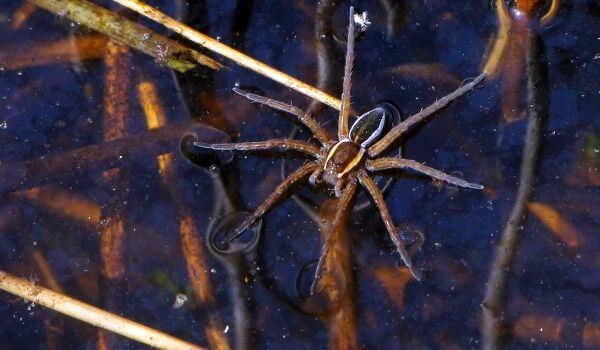
Photo: Water spider in Russia
They nest in groups, although each individual lives in its own nest at a small distance from the others. They do not conflict with each other, but in rare cases cases of cannibalism are known. This is also possible when kept in captivity, if too many silverfish live in one aquarium.
Both individuals of the same sex and different ones can live nearby, since female water spiders are not inclined to eat males. Often spiders live in pairs, placing nests in close proximity to each other. They breed in the female's nest.
When a warm spring sets in, the female carrying eggs lays a clutch in her nest: usually there are about 30-40 eggs in it, sometimes much more – over one and a half hundred. She separates the masonry from the rest of the nest with a partition and then protects it from intrusions, practically without leaving.
After a few weeks, spiderlings appear from the eggs – they are developed in the same way as adults, only less. The mother spider continues to take care of them until they leave her – this happens quickly, the spiders grow up in just two to three weeks. After that, they build their own nest, most often in the same reservoir.
Although sometimes they can travel, for example, if there are already a lot of silverfish where they were born. Then they climb a plant, launch a thread and fly on it with the wind until they reach another body of water – and if that does not fit, they can fly further.
Interesting fact: When keeping in captivity, small spiders must be relocated, because otherwise there will be too little space in it, and they may even be eaten by their own mother. This does not occur naturally.
Water spiders' natural enemies
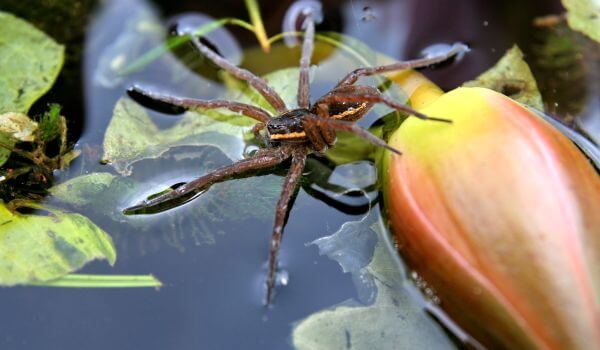
Photo: Water spider, or silverfish
Although they themselves are dexterous and dangerous predators for small aquatic animals, they they have many enemies. There are almost no threats in the nest, but when they get out to hunt, they themselves risk becoming prey – sometimes this happens, and the nest loses its owner.
Among dangerous enemies:
- birds ;
- snakes;
- frogs;
- lizards;
- fish;
- dragonflies and other predatory aquatic insects .
Yet they face far fewer dangers than ordinary spiders, primarily due to the fact that they live in the water. Here, numerous land predators cannot reach them, but fish can eat them – and this threat should not be underestimated, because even a nest does not always protect against it.
Nevertheless, this is a reliable protection in many cases, and the system of threads stretching from it is no less important – thanks to them, the silverfish not only hunts, but also learns about the threat in a timely manner. Therefore, the main chance for predators to catch this spider by surprise and catch this spider is when it hunts itself, at these moments it is most defenseless. ends up in the teeth of predators – they usually have a relatively quiet life, which is why they are not ready to trade their water body for a much more disturbing habitat on land.
An interesting fact: Silverfish venom is quite toxic, but not dangerous for humans – usually there is redness or swelling at the site of the bite, and that's all. A child or a person with a weakened immune system may feel dizzy, feel unwell, and nausea may appear. In any case, everything will pass in a day or two.
Population and species status
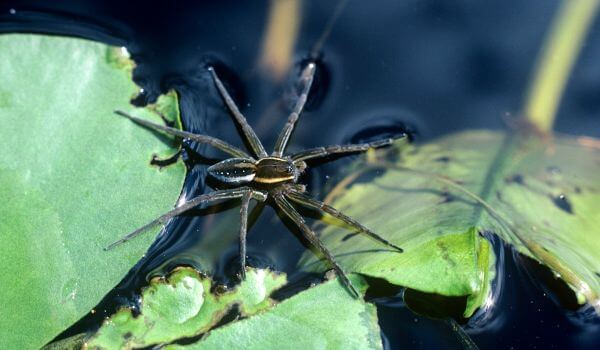
Photo: Water spider
Water spiders inhabit vast expanses of Eurasia, and can be found in almost every body of water, often in fairly large quantities. As a result, this species is considered to be among the least threatened – so far it clearly has no problems with the population size, although no calculations are being made.
Of course, the deterioration of the environment in many reservoirs could not but affect all living creatures living in them, however, silverfish suffer from this the least. To a lesser extent, but this can also be attributed to their prey, due to the disappearance of which they could also be forced to leave their habitats – various small insects, they are also not so easy to breed.
Thus, we can conclude that of all highly organized living organisms, extinction threatens most spiders, including silverfish, perhaps last but not least – these are perfectly adapted creatures that can survive even in extreme conditions.
Interesting fact: Silverwolves are sometimes kept in homes also because they are interesting to watch: they can cleverly use their web, showing peculiar “tricks”, and at the same time they are active most of the day – although this applies mainly to males , females are much calmer.
In addition, they are unpretentious: they only need to be fed and change the water from time to time. It is also necessary to close the container with them, otherwise the spider will sooner or later travel around your house in search of a new habitat, and maybe, what good, fly into the street or be accidentally crushed.
A water spider, even despite the fact that it is poisonous, the creature is harmless to people if it is not touched. It is unique in that it weaves its nets right in the water, constantly lives and hunts in it, even though it does not have a breathing apparatus adapted for underwater life. It is also interesting in that it can equip empty shells for hibernation.

